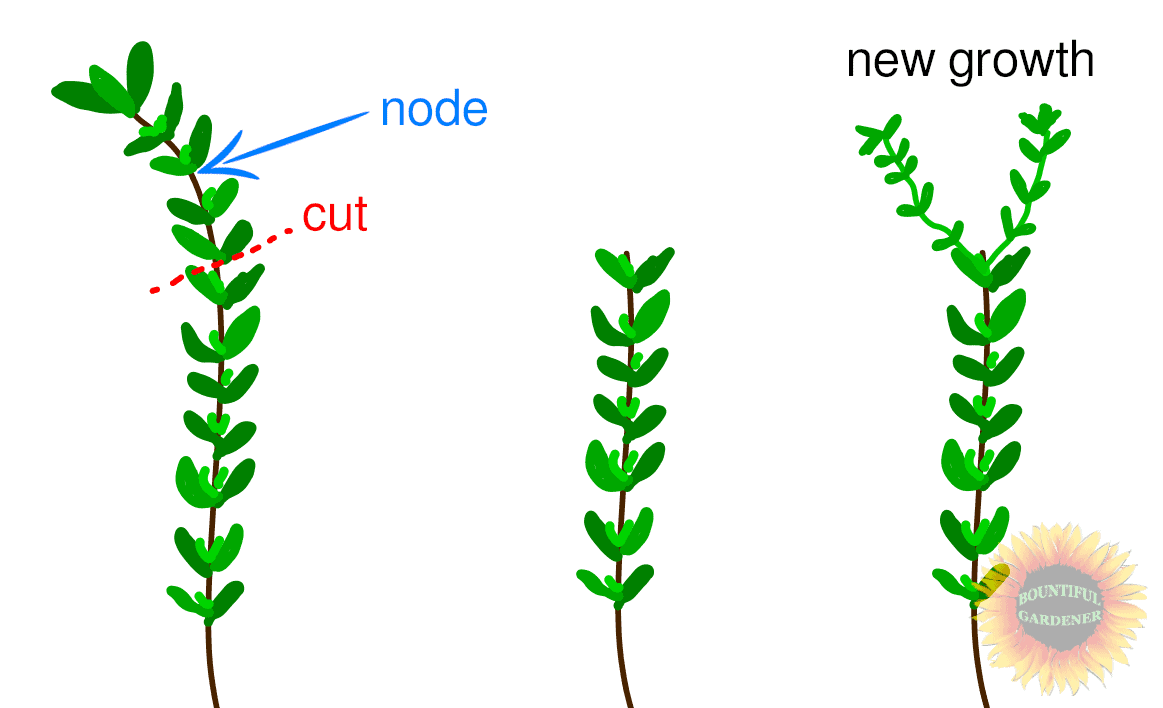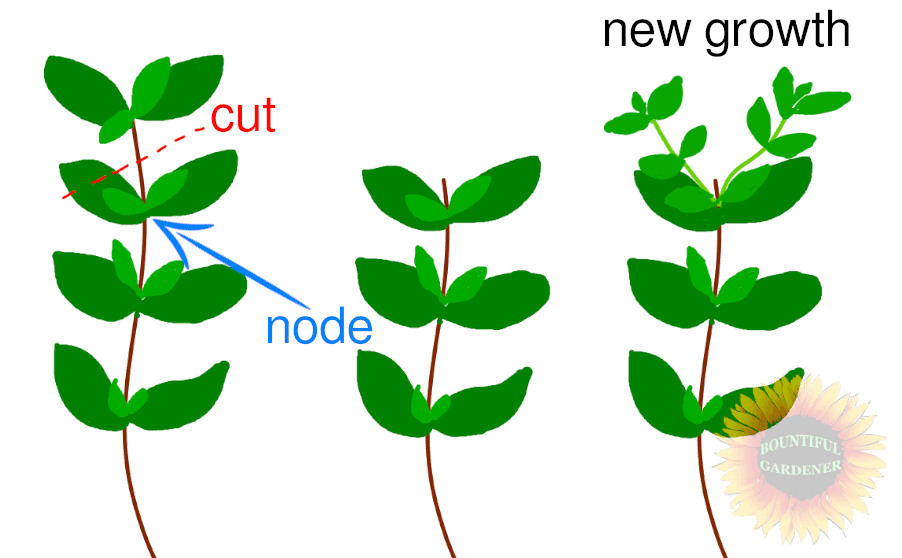Mint and thyme are among the most resilient herbs you can grow. They grow well in a variety of conditions and absolutely thrive indoors in an Aerogarden. Knowing how to prune your thyme and mint for maximum growth is easy to learn. The key to success is to make sure you don’t cut down to a bare stem without new leaf nodes. Below are some tips to get you started.
On this page:
Why You Should Prune Your Thyme and Mint
Whenever you harvest a thyme or mint branch, you are essentially pruning it. However, beyond that, pruning thyme and mint helps encourage bushier growth with more leaves, controls their size and shape, and can improve the quality of your harvests if they begin flowering. Furthermore, pruned branches can be used to propagate your mint and thyme plants.
Even if you aren’t regularly harvesting thyme and mint, it’s recommended to prune your herbs every so often. Whenever you cut a branch, the node (point on a branch where a set of leaves grow) below the cut will begin to grow out shoots which will grow into new branches. Over time, regular pruning will result in a bushier, sturdier plant with more branches and more leaves.
In an Aerogarden system, you also need to control the size of your thyme and mint, to keep them from touching the grow light and so they don’t completely crowd each other out.
Flowering can also reduce the quality of your thyme and mint. When thyme begins to flower, the stems become woodier, which may or may not be something you prefer. Meanwhile, flowering mint loses some of its aroma (although it is still fragrant). Pruning as soon as you see flower buds emerge can extend your harvest of high quality stems and leaves.
Pruning can also be used to propagate your thyme and mint. You can easily grow thyme and mint from new cuttings. You can take your Aerogarden herb cuttings and grow them in more Aerogarden systems, plant them in a pot or outside, or give them away to friends and family.
How to Prune Thyme Growing in an Aerogarden
Harvest thyme by cutting anywhere on the stem, just above a node (a point where a set of leaves grow). New branches will grow from that node. For more compact, bushier growth, prune lower on the plant, while still leaving at least one or two nodes for new shoots to grow.
Thyme plants are very easy to prune. Using some clean garden scissors, snip the stem or branch you want to prune, leaving at least one node below. Since each thyme branch has many nodes close together, it’s hard to make a mistake when pruning your thyme. The only way to kill a thyme plant from overpruning is if you prune down to a bare stem with no nodes.

To keep your thyme plant shorter and bushier in your Aerogarden, prune lower on the plant, while still leaving at least one (preferably a few) nodes below. As your thyme plant branches out, you can prune the branches, turning your thyme into a bushy, productive herb.
After pruning your thyme, there is nothing else you need to do, and you do not need to adjust your Aerogarden nutrients or light cycle. You should see new growth at the node below the cut you made after one to two weeks..
The main stem of a thyme plant gets much thicker and woodier over time, so as you prune it more, your thyme plant may even end up looking like a small tree. This also makes thyme one of the best herbs for bonsai.
How to Prune Mint Growing in an Aerogarden
When harvesting mint, cut anywhere on the stem, just above a node (a point where a set of leaves grow). New branches will grow from that node. For more compact, bushier growth, prune lower on the plant, while still leaving at least one or two nodes for new shoots to grow. Periodically check your mint for runners growing into your reservoir.
Treat pruning mint the same way you would thyme. Prune above a node, after which, two new shoots will grow, forking into two new branches. The next time you prune, you can prune each branch separately, leaving two nodes to sprout four new shoots. Repeating this will cause even more branching, which you can use to shape your mint plant into a small shrub.

One thing to note is that mint naturally sends out runners that grow into new plants. In your Aerogarden, you don’t have to worry about mint “taking over” like you would if planted outside. But you should also prune any mint runners you see growing into your reservoir.
You don’t need to do anything else after pruning your mint, and there is no need to adjust your Aerogarden nutrients or light cycle. After a week, sometimes sooner, you will begin to see the new shoots growing from the node below where you made the cut. Mint tends to grow back faster than thyme.
When Should You Prune Thyme and Mint?
You can prune mint and thyme at any time, and whenever you cut a branch to harvest them, you are essentially pruning them. It is also recommended to prune thyme and mint before flowering for the best quality harvests. In your Aerogarden, it is also advised to prune when any herbs that are touching or almost touching your grow lights, and it’s also a good idea to prune them to control their overall size so they don’t crowd each other out.
Both mint and thyme are perennial herbs, so you can harvest (prune) them at any time, and keep them growing back–which will happen faster in a hydroponic system like the Aerogarden. However, there are specific situations when it’s recommended to prune thyme and mint.
For both plants, you should prune them when they begin to grow too large and crowd each other out too much, or grow tall enough to touch your Aerogarden grow light. Prune them every so often to maintain their size and shape.
Thyme and mint also benefit from pruning before they begin to flower. Flowering in mint is associated with less fragrant leaves, and thyme branches tend to get woodier after flowering. So, for the most pungent mint and tender thyme stems, it’s best to prune when you begin seeing flower buds. (Pro-Tip: New thyme shoots with light green stems are very tender and soft.)
